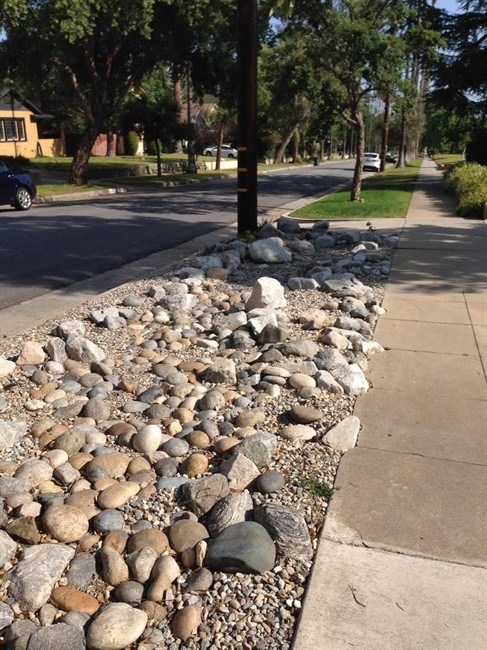
This May 19, 2015 photo provided by Solvej Schou shows a home's parkway median with its grass removed, and landscaped instead with drought tolerant shrubs, succulents, pebbles and rocks, in Pasadena, Calif. (Solvej Schou via AP)
May 26, 2015 - 12:00 PM
PASADENA, Calif. - Here in dry, dusty Southern California, dealing with the worst drought in state history has become the "new normal." In my home, we've cut back on showers and watering the lawn.
Banners declaring "Be Water Wise!" stretch above streets. Gov. Jerry Brown recently ordered mandatory restrictions to cut urban water use across California by 25 per cent.
Other western states, including Oregon, Nevada and Arizona, also have been plunged into extreme drought conditions.
For those wondering how to conserve water and lower water bills, here are five simple ways to slash home water use:
___
1. UNDERSTAND YOUR WATER METER
Madeline Ward, acting water conservation co-ordinator in Santa Barbara, suggests becoming familiar with your water meter, which is often located outside the house in a metal or concrete box.
Reading your meter — which looks similar to an odometer in a car — is not only a way to gauge water usage; it also can tell you if you have a leak.
"When you're leaving for work in the morning, read it," said Ward. "When you come back from work, read it again." It it's moved, there could be a leak.
Weekly meter readings are helpful for comparing usage week-to-week, added Forrest Arthur, general manager of a residential community in Carmel, the Santa Lucia Preserve, which relies on its own water supply. It cut 40 million gallons of water last year.
___
1. REPLACE YOUR GRASS LAWN WITH DROUGHT-TOLERANT PLANTS AND MATERIALS
Landscaping and turf watering generally account for a hefty 60 per cent to 80 per cent of home water use, according to Arthur and Ward, so one way to conserve water is to literally rip out your lawn.
As an incentive, water districts across many states, including California and Arizona, have been offering conservation rebates to residents who remove their lawn grass and replace it with drought-tolerant native plants, mulch, bark, gravel and drip-irrigation systems, which target plants at their roots.
"I have definitely seen an uptick in residential clients just in the last year, with all of them contacting me to take advantage of rebates," said Lupe Perez, owner of the Pasadena-based Green Splendor Landscaping.
___
1. MONITOR SPRINKLERS AND DON'T WATER DURING THE DAY
If you do keep your lawn, monitor automatic sprinklers closely to check for leaks or runoff, and make sure they're not on when it rains or during the day. Water is more likely to evaporate when the sun is at full strength.
Watering by hand is best, Ward added.
"You should water either when the sun goes down or before it comes up," said Arthur. "It really makes a big difference."
___
1. CHECK FOR TOILET LEAKS
Growing up in California, I always heard the flush-saving phrase, "if it's yellow, let it mellow."
While most toilets these days are low-flow and use 1.6 gallons of water per flush, according to Ward, a toilet leak can waste about 200 gallons of water a day. A DAY. These leaks are huge and silent.
One way to identify a leak, Ward said, is to do a dye test. Drop a food-colour tablet from a plumbing or other store into the toilet tank. Wait 10 to 15 minutes without flushing, and then look in the toilet bowl.
If there's colour in it, that means there's a leak from the tank into the bowl, and you need to replace the tank's rubber flapper that lets water through. Rubber flappers can warp or erode over time.
___
1. USE LESS WATER WASHING DISHES, CLOTHES, YOURSELF
No more long, hot showers or running water while flossing your teeth.
Instead, take five-minute showers. Showers usually use 1.5 to 2 gallons of water per minute, according to Ward. Turn off the water when you're lathering and shaving, and also at the sink when you lather your hands.
For baths, don't fill them more than halfway.
As for washing dishes, make sure the water isn't running when you're not using it. If you wash dishes by hand, dunk them in a basin with soapy water so you're just using extra water for rinsing. For dishwashers, always run a full load versus a half load, Ward said.
Likewise, in washing machines, always run full loads of laundry.
"We're going to have to get away from what we've done in the past since water is getting scarcer," said Arthur. "It's time to make a change."
____
Online:
Water saving tips tool launching May 26: http://watergenius.com/
City of Santa Barbara: http://www.santabarbaraca.gov/gov/depts/pw/resources/conservation/default.asp
___
Follow Solvej Schou at www.twitter.com/Solvej_Schou
News from © The Associated Press, 2015